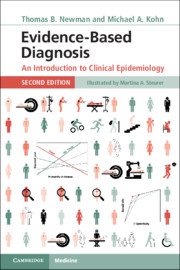Book contents
- Evidence-Based Diagnosis
- Evidence-Based Diagnosis
- Copyright page
- Dedication
- Contents
- Preface
- Acknowledgments
- Chapter 1 Introduction
- Chapter 2 Dichotomous Tests
- Chapter 3 Multilevel and Continuous Tests
- Chapter 4 Critical Appraisal of Studies of Diagnostic Test Accuracy
- Chapter 5 Reliability and Measurement Error
- Chapter 6 Risk Predictions
- Chapter 7 Multiple Tests and Multivariable Risk Models
- Chapter 8 Quantifying Treatment Effects Using Randomized Trials
- Chapter 9 Alternatives to Randomized Trials for Estimating Treatment Effects
- Chapter 10 Screening Tests
- Chapter 11 Understanding P-Values and Confidence Intervals
- Chapter 12 Challenges for Evidence-Based Diagnosis
- Answers to Problems
- Index
- References
Chapter 7 - Multiple Tests and Multivariable Risk Models
Published online by Cambridge University Press: 02 May 2020
- Evidence-Based Diagnosis
- Evidence-Based Diagnosis
- Copyright page
- Dedication
- Contents
- Preface
- Acknowledgments
- Chapter 1 Introduction
- Chapter 2 Dichotomous Tests
- Chapter 3 Multilevel and Continuous Tests
- Chapter 4 Critical Appraisal of Studies of Diagnostic Test Accuracy
- Chapter 5 Reliability and Measurement Error
- Chapter 6 Risk Predictions
- Chapter 7 Multiple Tests and Multivariable Risk Models
- Chapter 8 Quantifying Treatment Effects Using Randomized Trials
- Chapter 9 Alternatives to Randomized Trials for Estimating Treatment Effects
- Chapter 10 Screening Tests
- Chapter 11 Understanding P-Values and Confidence Intervals
- Chapter 12 Challenges for Evidence-Based Diagnosis
- Answers to Problems
- Index
- References
Summary
At this point, we know how to use the result of a single test to update the probability of disease but not how to combine the results from multiple tests, and we can evaluate risk prediction models but not create them. In making a clinical treatment decision (or any other decision), we usually consider multiple variables. This chapter is about combining the results of multiple tests with other information to estimate the probability of a disease or the risk of an outcome. We begin by reviewing the concept of test independence and then discuss how to deal with departures from independence, which are probably the rule rather than the exception. Next, we cover two common methods of combining variables to predict a binary condition or outcome: classification trees and logistic regression. Finally, we discuss the process and pitfalls of variable selection and the importance of model validation.
- Type
- Chapter
- Information
- Evidence-Based DiagnosisAn Introduction to Clinical Epidemiology, pp. 175 - 204Publisher: Cambridge University PressPrint publication year: 2020



